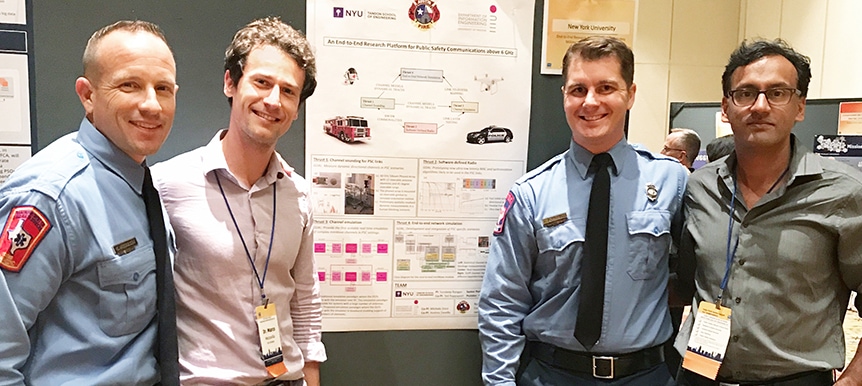The Quest Begins to Bring Ultra-speed Wireless Connectivity to First Responders

Researchers met in San Antonio, Texas yesterday to jump-start technology that could enable first responders to relay video in moving ambulances, employ virtual reality in emergencies, receive high-definition images from drones in real time, or control robots in restricted indoor environments too dangerous for humans.
Although the technology of ultra-fast fifth-generation, or 5G, wireless communication is nearing its first public deployment, millimeter-wave (mmWave) technology for such public safety communications is less understood and presents unique challenges.
But earlier this week, the U.S. Commerce Department’s National Institute of Standards and Technology (NIST) awarded $2.3 million over three years to the NYU WIRELESS research center at the New York University Tandon School of Engineering, which will work with Italy’s University of Padova, the Austin Fire Department, and NYU WIRELESS industrial affiliates to create a research platform for public safety communications using frequencies above 6 gigahertz, in the mmWave spectrum.
The researchers immediately convened in San Antonio, Texas, to begin executing their plans to greatly reduce the time to bring mmWave technology to public safety communications. Within three years, they aim to develop fundamental research on the behavior of the radio waves, channel measurements and models, and public safety–specific findings for technology such as antennae and testing equipment, as well as an end-to-end system simulation of a complex public safety scenario. The researchers plan to develop the first free and open-source channel sounding, emulation, and simulation tools for designing and testing public safety communications equipment.
“Our team is grateful for this NIST grant, which will allow us to expand the knowledge we have been building about millimeter wave technology into a new area that is not just intellectually challenging but one that will ultimately save lives,” said Sundeep Rangan, who leads the project, directs NYU WIRELESS, and is an associate professor of electrical and computer engineering at NYU Tandon. Marco Mezzavilla, an NYU WIRELESS research scientist and program director for the NIST project added, “We plan to apply the lessons we learned at NYU WIRELESS in accelerating the pace of 5G cellular technology to this new project and demonstrate novel use cases not possible with earlier 4G systems.”
Not only must emergency communications cover land and air, they must also occasionally build their own networks, for example, when a hurricane takes down cell towers. Another challenge: Communication must be robust and reliable – link failures that mean nothing more than a dropped call for mobile phone users could crash an autonomous vehicle, for example. And emergency vehicles move rapidly – presenting a severe “handoff” challenge for antennae. The researchers plan to address all these mmWave issues, plus provide the vast mmWave bandwidth needed to communicate with many first responders simultaneously.
In the first phase of their work, they will develop special channel soundings for these emergency systems, including peer-to-peer and aerial and vehicular links not required for cellular and WiFi systems, as well as signal blockage and mobility issues that are not yet fully understood.
Other research will develop software-defined radio systems to deliver ultra-reliability. Complex channel emulation will be needed to scale to the bandwidth and for the large number of antennae required for mmWave. Based upon their experience with commercial mmWave modeling, the researchers hope to vastly simplify channel processing.
NYU WIRELESS is home to pioneering mmWave research including the propagation measurements, radio channel modeling, system simulation, and antenna technology that are the foundation for 5G. National Instruments, an industrial affiliate of NYU WIRELESS, will provide much of the equipment and software, and NYU students have worked extensively at NI to develop key components.
“As 5G gets closer to becoming a commercial reality, there is still a lot of work to be done when it comes to making 5G ready for public safety communications,” said James Kimery, director of RF research and SDR marketing at NI. “We have a long history of collaboration with NYU WIRELESS on pushing the boundaries of mmWave research and as an Austin-based company we’re doubly excited to work with them on research that could ultimately impact our local community in emergency situations.”
Theodore (Ted) S. Rappaport, the founding director of NYU WIRELESS and NYU Tandon’s David Lee/Ernst Weber Professor of Electrical Engineering, is a co-principal investigator, along with the noted wireless researchers Michele Zorzi and Andrea Zanella of the University of Padova. Post-Doctoral Research Fellow Aditya Dhananjay will supervise much of the hardware development.
The Austin Fire Department’s Robotics Emergency Deployment Team is at the forefront of the use of robotics in emergency incident management. AFD was the first metropolitan fire department in the country to receive a Certificate of Authorization from the Federal Aviation Administration to use drone technology in real-time, public safety capacities. The team is already testing air, ground, and maritime robotic platforms to establish an industry standard for the first rescue-specific robots. For this project, the Austin Fire Department will consult on the design of test scenarios and may even test prototypes. The city’s hilly geography poses a difficult mmWave challenge.
The grant to NYU and its partners was the largest of 33 NIST grants announced this week for research and development projects aimed at advancing broadband communications technologies for first responders. The grants are part of the Public Safety Innovation Accelerator Program funded by NIST’s $300 million allocation from the 2015 auction of advanced wireless service licenses.

 2025 Brooklyn 6G Summit — November 5-7
2025 Brooklyn 6G Summit — November 5-7 Sundeep Rangan & Team Receive NTIA Award
Sundeep Rangan & Team Receive NTIA Award 2025 Open House
2025 Open House








